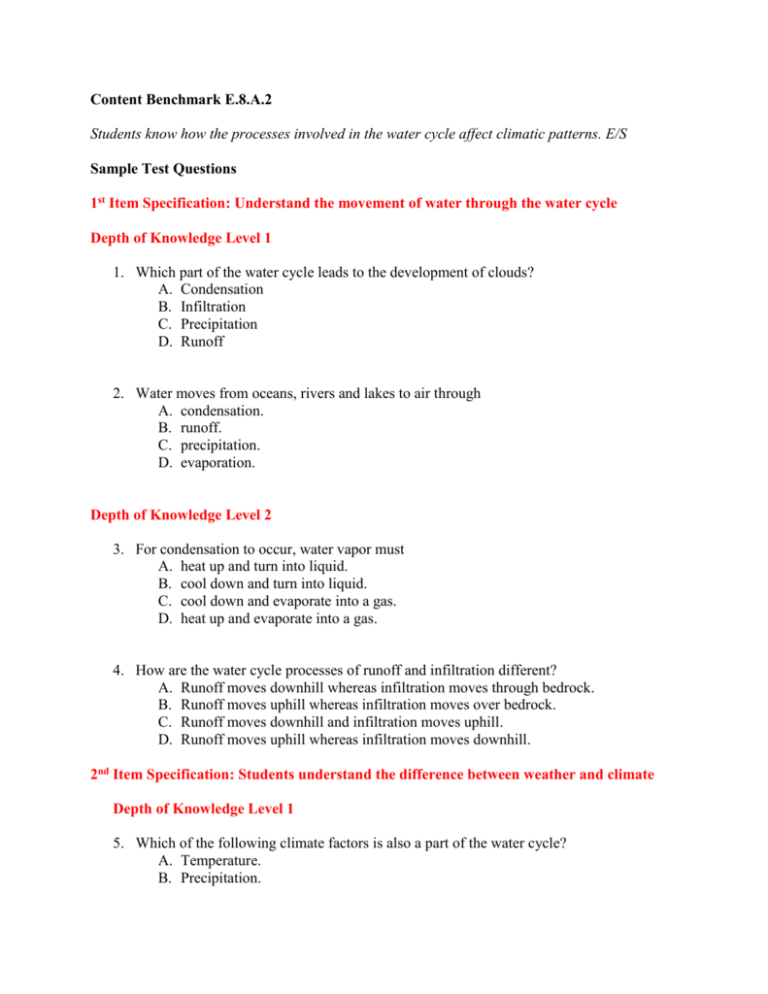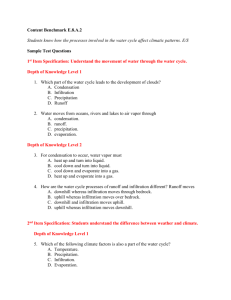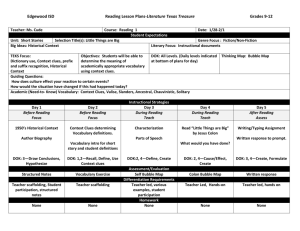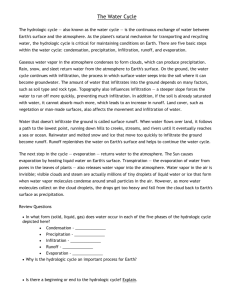E8A2_CRT_CR_MSTIPS_Final
advertisement

Content Benchmark E.8.A.2 Students know how the processes involved in the water cycle affect climatic patterns. E/S Sample Test Questions 1st Item Specification: Understand the movement of water through the water cycle Depth of Knowledge Level 1 1. Which part of the water cycle leads to the development of clouds? A. Condensation B. Infiltration C. Precipitation D. Runoff 2. Water moves from oceans, rivers and lakes to air through A. condensation. B. runoff. C. precipitation. D. evaporation. Depth of Knowledge Level 2 3. For condensation to occur, water vapor must A. heat up and turn into liquid. B. cool down and turn into liquid. C. cool down and evaporate into a gas. D. heat up and evaporate into a gas. 4. How are the water cycle processes of runoff and infiltration different? A. Runoff moves downhill whereas infiltration moves through bedrock. B. Runoff moves uphill whereas infiltration moves over bedrock. C. Runoff moves downhill and infiltration moves uphill. D. Runoff moves uphill whereas infiltration moves downhill. 2nd Item Specification: Students understand the difference between weather and climate Depth of Knowledge Level 1 5. Which of the following climate factors is also a part of the water cycle? A. Temperature. B. Precipitation. C. Wind. D. Evaporation. 6. Climate measures the average rainfall and temperature, which is averaged over the following time interval? A. 48 hours B. One week C. One year D. Thirty years 7. A heavy rainfall impacts a climate region by A. increasing the average temperature. B. decreasing the average temperature. C. decreasing the average precipitation. D. increasing the average precipitation. Depth of Knowledge Level 2 8. A primary difference between weather and climate is how the variables are measured A. with different tools. B. at different time intervals. C. over a twenty four hour span. D. over a thirty year span. 9. Understanding the climate for a typical region allows a person to A. anticipate what the weather is likely to be in a give month. B. know exactly what a particulars day’s weather will be weeks in advance. C. not have any idea what the weather will be like in a given month. D. know the daily high temperature for the next several days. 3rd Item Specification: Students will understand the role convection has in the water cycle, weather and climate Depth of Knowledge Level 1 10. Convection in the oceans and atmosphere is a result of the difference in A. mass. B. temperature. C. weight. D. volume. 11. As the sun heats up the surface of the ocean, convection currents can increase A. evaporation. B. runoff. C. precipitation. D. condensation. Depth of Knowledge Level 2 12. Convection in the atmosphere causes which of the following? A. Evaporation B. Precipitation C. Rainfall D. Runoff 4th Item Specification: Describe water in the atmosphere as water vapor, clouds, ice crystals and their role as a greenhouse gas. Depth of Knowledge Level 1 13. Water suspended in high altitude clouds are likely to be in the form of A. water vapor. B. ice crystals. C. snow. D. rain. 14. Which of the following is considered a greenhouse gas? A. Carbon monoxide B. Water vapor C. Ammonia D. Argon Depth of Knowledge Level 2 15. At very high altitudes clouds are likely composed of A. gas. B. water droplets. C. ice crystals. D. hail stones. Constructed Response E.8.A.2 A. Describe the role of evaporation in the water cycle. B. If precipitation increased in the desert over thirty years, what is a possible effect on the climate? C. How would an increase in precipitation affect the climate zones on the leeward and windward sides of a rainshadow? Explain your answer. Content Benchmark E.8.A.2 Students know the processes involved in the water cycle affect climatic patterns. E/S Answers to Sample Test Questions 1. A, DOK level 1 2. D, DOK level 1 3. B, DOK level 2 4. A, DOK level 2 5. B, DOK level 1 6. D, DOK level 1 7. D, DOK 2 level 8. B, DOK level 2 9. A, DOK level 2 10 B, DOK level 1 11. A, DOK level 1 12. B, DOK level 2 13. B, DOK level 2 14. B, DOK level 1 15. C, DOK level 2 Constructed Response E.8.A.2 Score Rubric: 3 points 2 points Response addresses all parts of the question clearly and correctly. A. Evaporation is the process of liquid water changing to water vapor as a result in the increase in heat. B. An effect on the desert climate can be the change in the classification to a steppe area or some other climate that is wetter than a desert. C. Students recognize that the windward side of a rainshadow would receive more precipitation where the leeward side would receive less precipitation. Response addresses all parts of the question and includes only minor errors. Response does not address all parts of the question. 1 point The response is totally incorrect or no response provided. 0 points










